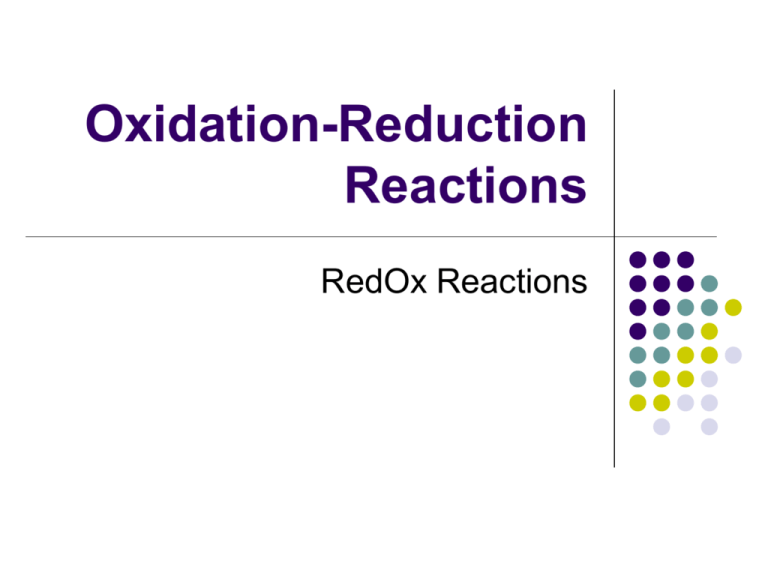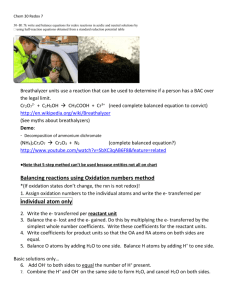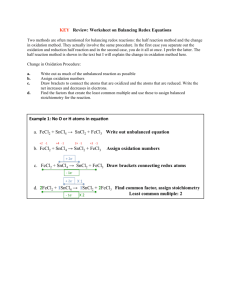Oxidation-Reduction Reactions
advertisement

Oxidation-Reduction Reactions RedOx Reactions It’s barely chemistry… In an oxidation-reduction reaction (abbreviated “redox” reaction), the only thing that changes is the “oxidation state” of the atoms involved. What is an “oxidation state”? The simplest way to think about an “oxidation state” is that it is the charge the atom has or could have if you separated it from the atoms it is bonded to. Ionic compounds For an ion or an ionic compound, the oxidation state is easy: it’s the charge on the ion. FeCl3 – Fe must be +3 because there are 3 Clions stuck to it. MnO2 – Mn must be +4 because there are 2 O2stuck to it. Covalent compounds Here is where it is a little tricky. The atoms in a covalent compound don’t have a real charge on them. BUT, they do have a potential charge if you pulled them all apart and the electrons they share get split up. CO – carbon must be +2 since O wants to be -2 CO2 – carbon must be +4 since there are 2 O that want to be -2 each Rules for Oxidation states 1. 2. 3. 4. Free element is 0 – including diatomics: Cu, Cl2, O2 are all ZERO. An ion’s charge is its oxidation state The sum of the oxidation states of all atoms in a molecule equal the charge of the molecule. Group 1a metals are always +1, Group 2a metals are always +2 Group VIIa nonmetals are usually -1 Group VIa nonmetals are usually -2 What’s the oxidation state of the atoms? SrBr2 Br is a halogen – it must be -1 when bonded to a metal Sr must be +2 SO3 O is usually -2, which means S must be +6 What’s the oxidation state of the atoms? CO32O is usually -2, which means C must be +4 since the entire molecule is -2 NO3O is usually -2, which means N must be +5 since the entire moecule is -1 Simplest Redox Reaction Fe2+ + Mn5+ → Fe3+ + Mn2+ There is a transfer of electrons from the iron to the manganese resulting in the change in charge of each of them. Balancing Redox Reactions Fe2+ + Mn5+ → Fe3+ + Mn2+ Balancing redox reactions require the ELECTRONS to be balanced as well as the atoms. 3 Fe2+ + Mn5+ → 3 Fe3+ + Mn2+ (Chapter 18 discusses balancing in greater detail) Recognizing redox reactions All redox reactions involve 2 species that change oxidation state. It’s a “donation” of electrons and, like acid/base chemistry, you can’t have a donor without an acceptor! 3 Fe2+ + Donor Loses eOxidized Mn5+ → 3 Fe3+ + Mn2+ Acceptor Gains eReduced Reducing agent Oxidizing Agent Predicting Redox Reactions We can’t do it! (At least not until Chapter 18 ) For now, we’ll limit ourselves to recognizing them when we see them. Combustion Combustion – burning in the presence of oxygen – is often an example of a redox reaction: CH4 + O2 → CO2 + H2O First thing you should notice: Oxygen gets combined! O2 has a “0” oxidation state, it becomes “-2” when combined. What else is changing oxidation state? C – it is -4 in CH4 and +4 in CO2! Recognizing Redox reactions What gets oxidized, what gets reduced? 4 Li + O2 → 2 Li2O Mg + Fe(NO3)2 → Mg(NO3)2 + Fe Clicker Question Which of the following is a redox reaction: A. Li(s) + O2 (g) → Li2O (s) B. Pb(NO3)2 (s) + Na2SO4 (s) → PbSO4 (s) + 2 NaNO3 (s) C. Mg(s) + Br2 (l) → MgBr2 (s) D. A and C E. A, B, and C.







